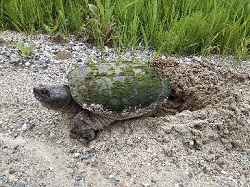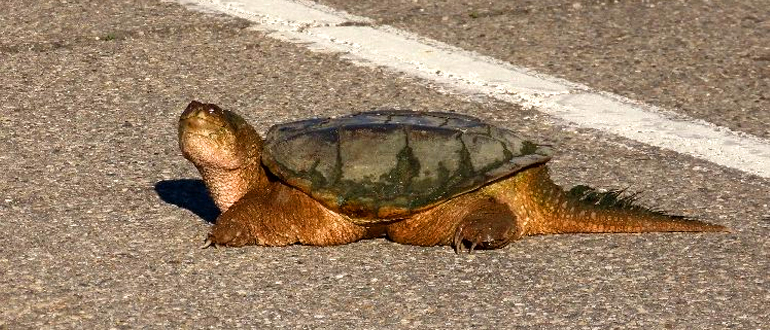Why did the turtle cross the road?
GET TO KNOW snapping turtles
Why did the turtle cross the road — to lay an egg, of course!
FUN FACT: Female snapping turtles lay their eggs in shallow nests on land. They may travel several miles over land to reach a favorite nesting site.
If you see a snapping turtle trying to cross a busy road (most likely a female heading to her nesting site), you can help it get to the other side safely. ALWAYS help it cross the road in the direction in which it is heading. While you may think the other direction is better, they have specific areas they go to and they will just try again once you are gone and get hit. Watch this YouTube video for how to help move it safely.
Snapping turtles have a reputation of being the tough guy of the watershed. However, in spite of their name, these “snappers” are generally passive, solitary creatures. They only bite to hunt or defend themselves. Otherwise, they spend their day peacefully crawling around the bottom of a pond.
PHYSICAL CHARACTERISTICS
Blessed with naturally long lifespans, wild snapping turtles are known to live up to 45 years. During this time, they continue to grow and may reach a shell size of 18.5 inches long and a weight of 35 pounds. Dark brownish / black in color, they have heavy shells, with concentric rings that provide a rough estimate of age in years. A snapping turtle’s tail is approximately as long as its shell and lined with bony plates. (Note: never pick-up a snapper by its tail. This will injure the turtle.) Due to the small size and shape of their bottom shell, snapping turtles are one of the few turtle species that cannot fully retract their long neck and head into their shell. All in all, snapping turtles sport a rather dinosaur-like appearance because, as some scientists say, the species hasn’t changed much since it evolved around 90 million years ago.
Snapping turtles are omnivores who eat both aquatic vegetation and any creature they catch including insects, fish, frogs, birds, and small mammals. Additionally, they will eat carrion and other turtles. While they do not have teeth, snapping turtles do use their strong, beak-like jaws to catch and tear prey. Mature snappers hide and hunt by ambushing passing prey, but baby turtles have to forage and eat whatever they can find.
HABITAT & LIFE CYCLE
Snappers live in slow moving freshwater ponds, marshes, and lakes. Because they like to hide at the bottom of the pool, they require abundant vegetation and muddy/sandy pool bottoms to burrow into. Their natural range extends from southeastern Canada down to the Gulf of Mexico and as far west as the US Rocky Mountains.
During most of the year, a turtle breaths air through nostrils at the tip of its head and absorbs air through its lungs. While snapping turtles are capable of staying submerged for long periods, they occasionally must rise to the surface and breath. In order to survive winter, these turtles hibernate in the cold water below the frozen surface. Their oxygen needs decline with the water temperature. They survive by absorbing tiny amounts of dissolved oxygen through their cloaca opening. The cloaca is a highly vascular, multi-purpose opening that also conducts excretion and reproduction activities. (Note: In addition to turtles, all reptiles, amphibians and birds have a single cloaca opening for both excretion and reproduction purposes.)
Snapping turtles remain juveniles for several years, and males mature earlier than females. Males reach maturity at approximately 4 – 5 years of age, while females mature at around eight years. After mating, mature females leave the water to find a nesting site where they scoop out a shallow nest with their hind feet. They lay a “clutch” of 20 – 50 round, white eggs that are the size of ping pong balls. After laying her eggs, the female covers up the nest with dirt and abandons it. Unfortunately, these unguarded nests are in danger from predators. If the nest is discovered, the turtle eggs may be eaten by raccoons, foxes, skunks, and crows. Eggs that survive, hatch in four to five months; and the tiny hatchlings (only about 1 inch in shell diameter) must find their own way to the water.

A female snapping turtle digs a shallow nest for her eggs. She will lay 20 – 50 eggs in one nest. Photo by Robin Ottawa CC-BY-SA-2.0
Snapping turtle gender is determined by the average temperature during the egg incubation period. At ideal incubation temperatures of 70 – 72◦ F, eggs can mature into either male or female turtles. However, lower incubation temperatures result in female turtles, and higher temperatures result in male turtles.
Tiny turtle hatchlings face a dangerous trip to find water. During this time, they are easy prey for the same raccoons, foxes, and skunks that eat turtle eggs. Additionally, if they are lucky enough to reach the pond or stream, they become prey to bullfrogs, blue herons, large fish and bigger turtles. Young turtles live a life of constant danger as they forage for food. However, as snapping turtles grow and mature, they gradually transform from easy prey to top tier predators, and life becomes a peaceful crawl along the bottom of the pond.
TAKE ACTION
Snapping turtle populations are threatened by loss of natural habitat, chemical pollutants, over-hunting, and illegal poaching. Female turtles (and their eggs and hatchlings) face ever increasing risks from loss of natural nesting sites. As female snapping turtles increasingly build their nests on crop land, golf courses, suburban yards and industrial lots, they face dangers from roadway accidents, agricultural / lawn equipment, digging dogs and over-fussy homeowners.
Friends of the Rouge works to preserve and maintain healthy riparian zones and natural water quality throughout the Rouge Watershed. You can help snapping turtles by reducing your use of chemicals, and by creating, restoring, and maintaining areas of natural vegetation.
MAIN PHOTO CREDIT: Common Snapping Turtle (Chelydra sepentina) crossing road in Rouge Park. photo by D. Hall – image cropped
